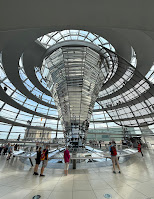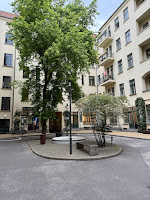June 2-4, 2025 - Berlin Trip - Day 1 of our weeklong visit to Berlin.
June 2-3
June 4 - Berlin - Day 1
During our first full day in Berlin we walked approximately 6 miles, took the S-bahns and only covered Mitte Berlin (one of 12 different Berlin sectors/burroughs).
Our exploration started with the iconic Brandenburg Gate area, where Christine and Richard shared personal memories of November 9, 1989 - the night the Berlin Wall fell. She had been at a choir rehearsal that evening and came home to find the momentous news on television. Despite the announcement that the border was open, she and Richard found it "unbelievable" and decided to drive to the Brandenburg Gate around 11 PM. When they first arrived there were hardly any people there, but within an hour the place was packed.
They told us about the "wall pickers" - people who spent days chipping away at the wall with hammers, creating the distinctive tick-tick-tick sound that echoed throughout the city.
(Lines in the street mark the location of the former wall - see photo above)
 The transparent architecture symbolizes that "the people are above the government" - a powerful democratic statement. We observed the contrast between the historical Brandenburg Gate area and the completely rebuilt government quarter, noting how Berlin differs from other capitals by not having a single defined center due to its divided past.
The transparent architecture symbolizes that "the people are above the government" - a powerful democratic statement. We observed the contrast between the historical Brandenburg Gate area and the completely rebuilt government quarter, noting how Berlin differs from other capitals by not having a single defined center due to its divided past.Christine provided us with crucial context about how the wall affected daily life in West Berlin. West Berlin was entirely surrounded by East Germany, making it an island of democracy within communist territory. Before reunification, moving between East and West required special permits and involved going through heavily monitored checkpoints.
When the wall was first built in 1961, people jumped from windows of buildings right at the border. The East German authorities responded by bricking up these windows, creating a grim appearance. And there are many tragic stories of people trying to flee - some shot while swimming across rivers, others killed attempting to cross the wall itself.
 |  |
|---|
We appreciated the family stories that Christine shared including that many women survived the Soviet advance into Berlin by hiding in a basement with other women, where they even built new walls to protect themselves from soldiers. And after the war, Christine's family regularly sent care packages to friends and relatives in East Germany, dealing with complicated bureaucratic requirements that limited what could be sent (like only half a pound of coffee).
Throughout our walk, Richard pointed out the Stolpersteine - small brass memorial plaques embedded in sidewalks. Each stone marks where a specific Jewish family or individual lived before deportation.
We walked through the Holocaust memorial aptly named the "Memorial to Murdered Jews of Europe". The varying heights of the concrete blocks (from small to over 4 meters tall) create a maze-like experience and walking through the memorial creates feelings of disorientation and unease. Christine mentioned there was significant debate about building such a large memorial, but ultimately the decision was made that "it's just what was needed".
Walking through the Museum Island area, we discussed the various museums housing everything from ancient artifacts to the famous Nefertiti bust. Here we are standing in front of the Altes Museum which was built between 1825 and 1830 by order of King Frederick William III of Prussia according to plans by Karl Friedrich Schinkel, it is considered a major work of German Neoclassical architecture.
Ampelmann (traffic light man) is the symbol shown on pedestrian signals in Germany. The Ampelmann was created in 1961 by East German traffic psychologist Karl Peglau as part of a road safety campaign. Unlike the generic stick figures used in West Germany, the East German version featured a man wearing a hat. It is one of the few features of East Germany that survived the fall of the wall and gained a "cult" status. Today it is a popular tourist item. I, of course, came home with two keychains representing the two symbols.
Christine guided us through Hackescher Markt Area which features traditional Berlin architecture features connected courtyards (Höfe) with hidden passages. This area which was part of the former East Berlin has been transformed and now hosts unique, locally-made clothing, cafes and art. (see below)
 |  |  |
|---|
We had a very nice, inexpensive dinner (compared to home) at the Creasian Restaurant in the Hackescher Markt area. It is an Asian Fusion Restaurant featuring dishes from Vietnam, Indonesia, Korea, Japan, Thailand and China.
Our first day in Berlin, guided by Christine and Richard's remarkable memories and deep personal connection to the city's history, emphasized to us that Berlin is a city honestly confronts its traumatic past while enthusiastically embracing its democratic future.
The approximately 15,000 steps we took covered not just physical distance but decades of complex history, making this a truly comprehensive introduction to one of Europe's most historically significant capitals.















Comments